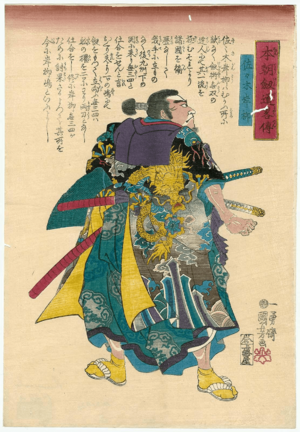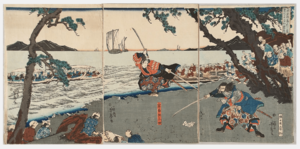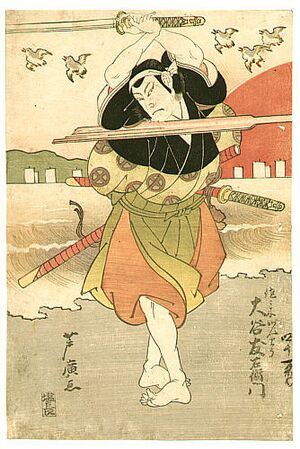Sasaki Kojirō facts for kids
Quick facts for kids Sasaki Kojirō |
|
|---|---|

Sasaki Ganryû (Sasaki Kojiro) by Utagawa Kuniyoshi (1845)
|
|
| Born | c. 1585 Fukui Prefecture, Japan |
| Died | April 13, 1612 (aged 26–27) Ganryū-jima, Japan |
| Native name | 佐々木 小次郎 |
| Residence | Japan |
| Style | Ganryū |
Sasaki Kojirō (佐々木 小次郎, also known as Ganryū Kojirō; c. 1585 – April 13, 1612) was a famous Japanese swordsman. He lived during the late 1500s and early 1600s. He is most known for his duel with Miyamoto Musashi in 1612. In this famous fight, Sasaki Kojirō was killed. Even though he lost, he is still seen as a respected warrior in Japanese history. Miyamoto Musashi himself later said that Sasaki Kojirō was the toughest opponent he ever faced.
Contents
Sasaki Kojirō's Life and Training
Sasaki Kojirō used the fighting name Ganryū (巌流, "Large Rock style"). This was also the name of the sword fighting school he started. People say Sasaki learned a sword fighting style called Chūjō-ryu. He may have learned it from Kanemaki Jisai or Toda Seigen. Toda Seigen was a master of the kodachi, which is a short sword.
If Sasaki learned from Seigen, he would have practiced with his master. Because his master used a short sword, Sasaki used a nodachi. This is a very long katana, or Japanese sword. He became very good at using this long sword. After beating his master's younger brother, he left and started his own Ganryū school.
The first clear records of his life show that by 1610, he was very famous. His school was well-known, and he had won many duels. Lord Hosokawa Tadaoki honored Sasaki. He made him the main weapons master for the Hosokawa area in northern Kyūshū. Sasaki was known for using his long nodachi. He called it monohoshizao, which means "The Laundry-Drying Pole." This was his main and strongest weapon.
The Famous Duel with Miyamoto Musashi
Sasaki Kojirō was a long-time rival of Miyamoto Musashi. Musashi himself thought Kojirō was the most challenging fighter he ever met. There are many stories about their duel. Most details are different, but the main point is always that Kojirō was defeated.
Kojirō's exact age during the duel is not clear. Some old stories say he was 18, but this seems unlikely. He was already a head weapons master two years before the duel. This would mean he got that job at 16, which was very rare. Also, his teacher Toda Seigen died in the 1590s. This means Sasaki could have been anywhere from his 20s to his 50s. Some experts even think his teacher was actually Kanemaki Jisai, a student of Seigen's.
Like Musashi, Sasaki was very tall for his time. He was about 1.78 meters (5 feet 10 inches) tall. This was much taller than the average Japanese person back then.
Setting Up the Duel
Young Musashi, who was about 29 years old, heard about Sasaki's fame. He asked Lord Hosokawa Tadaoki to arrange a duel. A helper named Nagaoka Sado Okinaga helped set it up. Lord Tadaoki agreed. They chose the date as April 13, 1612. The duel took place on a quiet island called Ganryujima, also known as Funashima. This island is in the strait between Honshū and Kyūshū.
The fight was probably held in such a remote place for a reason. By this time, Sasaki had many students and followers. If Sasaki lost, his students might have tried to kill Musashi.
The Fight on Ganryū Island
According to the legend, Musashi arrived more than three hours late. He tried to make Sasaki angry by teasing him. When Sasaki attacked, his sword came so close it cut off Musashi's chonmage (a traditional topknot hairstyle). Sasaki almost won several times.
Then, the story says, Sasaki was blinded by the sunset behind Musashi. Musashi then hit Sasaki on the head with his extra-long bokken. A bokken is a wooden sword. Musashi's bokken was 110 cm (about 3.6 feet) long. Musashi supposedly made this long bokken by shaping a spare oar from his boat. He used his wakizashi (a short sword) to carve it.
Musashi purposely arrived late to make his opponent nervous. He had used this trick before in other duels.
Different Stories of the Duel
Another version of the legend says that when Musashi finally arrived, Sasaki yelled insults at him. But Musashi just smiled. This made Sasaki even angrier, and he rushed into the fight filled with rage. Sasaki tried his famous "swallow's blade" or "swallow cut" technique. But Musashi's long bokken hit Sasaki first, making him fall. Before Sasaki could finish his move, Musashi hit Sasaki's left ribs. This hurt his lungs and killed him. Musashi quickly got back into his boat and sailed away. This was Musashi's last duel where he killed an opponent.
Some parts of these stories have problems. For example, would Musashi really make his wooden sword while going to the duel? Would that not make him tired? Also, why was the island named after Sasaki, not Musashi? Some texts do not even mention Musashi arriving late.
Some experts believe that Sasaki was actually killed by Musashi and his students. They think the Sasaki family might have been a political problem for Lord Hosokawa. Defeating Sasaki would have been a political win for Hosokawa against his rivals.
People still debate today whether Musashi cheated to win or just used the situation to his advantage. Another idea is that Musashi timed his arrival with the turning of the tide. He knew Sasaki's supporters might chase him if he won. The tide carried him to the island, and then it turned when the fight ended. Musashi quickly jumped back in his boat, and the tide helped him escape.
Sasaki Kojirō's Weapon
Sasaki's favorite weapon was a straight-edged nodachi. This sword had a blade longer than 90 cm (about 3 feet). To compare, a regular katana usually has a blade around 70 cm (about 2 feet 3 inches). Sasaki called his nodachi monohoshizao, which means "Clothes/Laundry-Drying Pole." Even though the sword was long and heavy, Kojirō's attacks with it were very fast and exact.
The Famous Swallow Cut Technique
Sasaki Kojirō's most famous technique was respected and feared across feudal Japan. It was called the "Turning Swallow Cut" or Tsubame Gaeshi (燕返し, "Swallow Reversal / Return"). It got its name because it looked like the quick, turning motion of a swallow's tail as it flies. Sasaki saw this motion at Kintaibashi Bridge in Iwakuni.
This cut was said to be so fast and precise that it could hit a bird in mid-flight. We don't have exact descriptions of the technique. However, it was compared to two other moves from that time. These moves involved a strong, fast cut downwards, followed immediately by a quick cut upwards.
So, the "Turning Swallow Cut" is thought to be a move where Sasaki would strike downwards from above. Then, he would instantly strike again in an upward motion from below. The second part of the strike might have been from below, moving backward and then upwards at an angle. It was like an eagle climbing after diving for its prey. Sasaki created this amazing technique around 1605.
See also
 In Spanish: Sasaki Kojirō para niños
In Spanish: Sasaki Kojirō para niños
- Sasaki Kojirō in fiction
- Miyamoto Musashi in fiction



